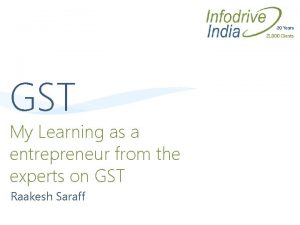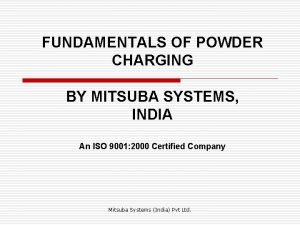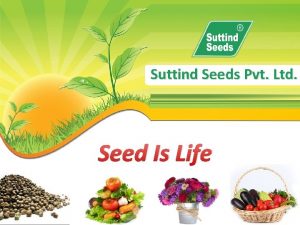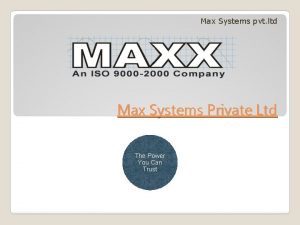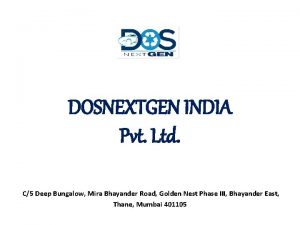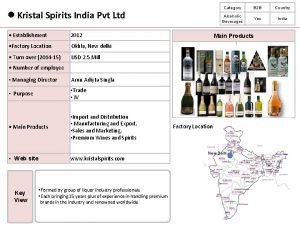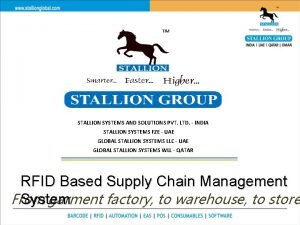MARKET SURVEYREPORT MAGGI INDIA PVT LTD CONTENTS Sr























- Slides: 23

MARKET SURVEYREPORT MAGGI INDIA PVT. LTD.

CONTENTS Sr. No 1 2 3 4 5 6 7 8 9 10 11 12 Particulars Introduction to Maggi Brand Story Various products of Maggi Taste and preference of consumers Demography and psychograph of consumers Market Share SWOT analysis of Maggi brand Research methodology Questionnaire Data Collected Analysis of questionnaire Conclusion Pg. No

INTRODUCTION Maggi is a Nestlé brand of instant soups, stocks, bouillon cubes, ketchups, sauces, seasonings and instant noodles. The original company came into existence in 1872 in Switzerland, when Julius Maggi took over his father's mill. It quickly became a pioneer of industrial food production, aiming at improving the nutritional intake of worker families. It was the first to bring protein-rich legume meal to the market, which was followed by ready-made soup based on legume meal in 1886. In 1897, Julius Maggi founded the company Maggi Gmb. H in the German town of Singen where it is still established today. Maggi Comes to India – teething troubles Maggi noodles was launched in India in the early 1980 s. Carlo M. Donati, the present Chairman and Managing Director of Nestle India Ltd, brought the instant noodle brand to India during his short stint here in the early eighties. At that time, there was no direct competition. The first competition came from the ready-to-eat snack segment which included snacks like samosas, biscuits or maybe peanuts, that were usually ‘the bought out’ type. The second competition came from the homemade snacks like pakoras or sandwiches. So there were no specific buy and make snack! Moreover both competitors had certain drawbacks in comparison. Snacks like samosas are usually bought out, and outside food is generally considered unhygienic and unhealthy. The other competitor, ‘homemade’ snacks overcame both these problems but had the disadvantage of extended preparation time at home. Maggi was positioned as the only hygienic homemade snack! Despite this, Nestlé faced difficulties with their sales after the initial phase. The reason being, the positioning of the product with the wrong target group. Nestle had positioned Maggi as a convenience food product aimed at the target group of working women who hardly found any time for cooking. Unfortunately this could not hold the product for very long. In the course of many market researches and surveys, the firm found that children were the biggest consumers of Maggi noodles. Quickly they repositioned it towards the kids segment with various tools of sales promotion like color pencils, sketch pens, fun books, Maggi clubs which worked wonders for the brand. Maggi was positioned as ‘ 2 -minute noodles’ with a punch line that said ‘Fast to cook! Good to eat!’ And this gave the implied understanding to the

consumer that it was a ‘between meals’ snack. The company could have easily positioned the product as a meal, either lunch or dinner. But, it chose not to do so, because the Indian consumer mindset did not accept anything other than rice or roti as a meal. Hence trying to substitute it with noodles would have been futile. The firm did not position it as a ‘ready-to-eat’ meal either, as the housewife prefers to ‘make’ a meal for her kids rather than buy it for them. And if she can make it in two minutes with very little effort, then obviously it’s a hit with her! What’s more, if kids also love the taste, the product is as good as sold! Sothe ‘ 2 - minute’ funda coupled with the ‘yummy taste worked!

BRAND STORY Launched in 5 flavors initially – Masala, chicken, Capsicum, sweet & sour, and Lasagna. Maggi had to fight hard to be accepted by Indian consumers with their hardto-change eating habits. The packaged food market was very small at this time; Nestle had to promote noodles as a concept, before it could promote Maggi as a brand. It therefore devised a two-pronged strategy to attract mothers on the ‘convenience’ plank and lure kids on the ‘fun’ plank. Gradually, the market for instant noodles began to grow. The company also decided to focus on promotions to increase the brand awareness. In the initial years, Nestle promotional activities for Maggi included schemes offering gifts( such as toys and utensils) in return for empty noodles pack. According to analysis the focus on promotion turned out to be the single largest factor responsible for Maggi’s rapid acceptance. Nestle’s Managers utilized promotions as measured to meet their sales target. Gradually, sales promotion became a crutch for Maggi noodles sales. Later many of the Maggi’s extensions also made considerable use of promotional schemes. The focus of all Maggi’s extensions was more on below the line activities rather than direct communication. In addition to promotional activities, Maggi associated itself with main stream television programmed and advertised heavily on kids programmed and channels. After its advertisements with taglines like “mummy bhookh lagi hai, bas do minute” and fast to cook good to eat Maggi’s popularity became highly attributed to its “extremely high appeal to children”. As a result, Maggi’s annual growth reportedly touched 15% during its initial years.

VARIOUS PRODUCTS The product mix of Maggi is divided into various categories defined below. The company has launched various products under each category as mentioned below. 1. Noodles a) Maggi 2 -Minute Noodle (Masala, Chicken, Curry and Tomato) b) Maggi Dal Atta Noodles (Sambhar taste) Vegetable Atta Maggi Noodles c) Maggi Rice Noodles (Lemon Masala, Chilly Chow and Shahi Pulao) d) Maggi Cuppa mania (Masala yo, Chilli chow yo) 2. Sauces a) Teekha masala Tomato chatpat Imli khata mitha Tomato ketchup Hot and sweet Tomato pudina b) Ginger, Garlic & Coriander c) Maggi Oriental Chilli Garlic d) Ginger, Garlic & Coriander 3. Maggi Pichko 4. Soups Healthy a) Chef Style i. Cream Mushroom ii. Sweet Sour Tomato Noodles iii. Tangy Tomato Vegetables b) Home Style i. Creamy Chicken ii. Mixed Vegetable iii. Rich Tomato

c) Chinese Style i. Chinese Hot Sour Chicken ii. Chinese Sweet Corn Chicken iii. Chinese Sweet Corn Vegetables iv. Chinese Hot & Sour Vegetables 5. Maggi soup sanjivni a) Amla b) Badam c) Spinach d) Dal e) Tomato 6. Maggi bhuna masala a) Bhuna masala for gravy dishes b) Bhuna masala for vegetable dal 7. Maggi magic cubes a) Chicken b) Vegetarian masala

TASTEAND PREFERENCESOF CONSUMERS Health is the flavour of the season. Food companies in India are growing aware of the increasingly changing consumption trends and taste preferences among the Indian junta. No surprises, but this is the reason more and more companies are coming up (or are actually re-marketing) with products that are healthy. Take for example Coke and Pepsi; both have already started looking into the non-carbonated drinks category section. Maggi first introduced in the market Maggi Atta Noodles – which it claimed was a healthy food as it was made of wheat flour followed by soups. Nestle India, in an effort to carry on with its trend of providing the Indian consumer’s healthy food recently introduced a range of Healthy Soups. The entire range consists of the following; maggi tomato, mixed vegetable, tomato vegetable, mushroom, chicken, sweet corn chicken and hot and sour vegetable. The product is priced at Rs 25 for 70 grams. Maggi became successful because it understood consumers. The brand never wanted to change Indian consumer’s habit. It did not have ambitions about changing Indian’s breakfast or dinner preferences. What Maggi did was to slowly attach itself to Indian consumer's need without disruption. Maggi was also closely watching consumer preferences. When consumers wanted healthy food, Maggi launched Atta Noodle variants that were healthy. More importantly this move addressed the concerns of Homemakers. The brand extended itself to multiple segments but without diluting the core brand equity. Maggi over these years have made lot of mistakes. It made mistakes because the brand was willing to experiment. More importantly the brand learned from those mistakes and corrected itself. Maggi also invested heavily in brand building. The campaigns for one of Maggi’s products were always there in the media which kept the brand fresh in the mind of the consumers. Maggi personifies the basic principles of understanding c o n s u m e r s , innovating and investing in the brand. Maggi is one packaged food brand that has only seen its popularity grow in the past many years and the secret to the success is that instead of trying to

change the food habits of consumers, it has tried to align itself with local tastes and preferences with the ‘fast to cook and good to eat’ promise. To commemorate its successful journey through a quarter of a century in the world’s largest consumer market, the brand, last year, launched an innovative campaign inviting its loyalists to share with it their Maggi stories and promised to broadcast them to the world at large, thereby, making them the superstars overnight. Along with television commercials, which aired individual consumer stories of their lasting memories of Maggi, the brand displayed pictures of these loyal customers on the Maggi packs. Nestle also introduced a website Meandmerimaggi. in for engaging with them. The company also rewarded its consumers by adding to the Maggi portfolio that hitherto had sauces and soups in various flavours, a range of prepared dishes and cooking aids such as Maggi Bhuna Masala and Maggi Pasta. So far focused on urban consumers, the company also made a pitch for rural consumers by launching Maggi Rasile Chow noodles at an inviting price of Rs 4. Again, local tastes and recipes have been at the core of all these marketing innovations. “Creating delight and happiness in everyday meals is not just about providing tasty food. It is about providing taste and health in a convenient combination, ” says Shivani Hegde, general manager, foods.

DEMOGRAPHY AND PSYCHOGRAPHYOF CONSUMERS Demography: - 1)Age and sex: - Maggi products are consumed by people of different age groups. They are consumed by children, teenagers, adults as well as old people. They are consumed by both genders male and female. 2)Income: - Maggi products are available at reasonable prices. So they are consumed by the lower, middle as well as the higher class. 3)Religion and nationality: - Maggi products are famous and are consumed by people of all religions andnationality. Psychograph: - 1)Attitude: - Consumers of maggi have a positive attitude towards the product which makes it the leader in the market. Maggi dominates the market. 2)Lifestyle: - Lifestyle determines the way of living of people. It describes how a consumer leads his life. Maggi products are consumed by all.

MARKET SHARE Maggi's Market Share in Ketchup Category 45% 55% Maggi Others Maggi has a market share of 45% which is a high percentage. It dominates the market in the ketchup segment.

Maggi's Market Sharein Noodles. Category 20% 80% Maggi Others Maggi has a market share of as high as 80% in the noodles segment. It dominates the market. It is the leader in this segment.

SWOT ANALYSISOFMAGGI BRAND The SWOT analysis of Maggi brand clearly indicates the strengths of Maggi as a Brand in Indian market. The Brand was found to be a leader in its category of Noodles, with strong customer loyalty. Intensive distribution of Maggi as a Brand was seen in urban areas of the country. The major threats of the brand as shown in the figure below indicates that Maggi has made several attempts to revamp itself as a ‘Healthy Product” but till date its perseverance towards the tag line is low by the consumers. The brand is in the growth stage of product life cycle with a strong inclination towards the maturity stage. SWOT ANALYSIS STRENGTH: Market leader in their segment. Strong brand loyal consumer base. Wide range of distribution channel. Product according to the need of Indian consumer. Innovative Product WEAKNESS: Product is dependent on each other Not so much presence in rural market OPPORTUNITY: Increasing number of working youth. Product has been acceptable in youth category. Shift to rural market. Changing preference of consumer towards Chinese food and fast food. Can foray into other food markets with its strong Brand name. THREAT: Price war with competitors. Strong presence of regional competitors. Consumers don’t perceive it as a “Healthy Product”.

RESEARCHMETHODOLOGY: METHOLODOGY The research will be carried out in the form of a survey. This will include primary research in addition to secondary research as stated below. The survey research method will be descriptive research design. Each respondent will be interviewed through a Questionnaire. The sample will be selected by a simple random sampling method. The survey will address the following information area: Information Areas: The objective as spelt out can be elaborated into specific information areas to be studied. How do customers perceive Maggi as a stable brand, their perception of noodles and how do they associate themselves with Maggi? Are the consumers aware of Maggi Brand or they associate noodles with some other brand? Which product from the entire basket of Maggi products do the consumers consider as the best selling product for Maggi and to which the consumers frequently buy? Are the consumers willing to accept Maggi brand extensions to some other products like chocolate, juices, chips etc?

QUESTIONNAIRE OBJECTIVESOFQUESTIONNAIRE To understand the influence of Maggi as a brand on consumers mind set. Sources of Brand equity of Maggi like Brand awareness, Brand image, Brand association, Brand recall. To understand the Brand performance of Maggi products. To understand Brand Imagery, Brand Quality perceived by customers, Brand credibility, consideration, superiority and feelings. To know the medium of media through which they became aware of Maggi. Q 1) Are you a consumer of Maggi? o Yes o No Q 2) what comes first in your mind when you hear the word Maggi? o o Noodles Fast food Snacks None of these Q 3) what is the brand that comes to your mind when we say the word noodles? o o Maggi Top Ramen Surya Noodles Anil Noodles

Q 4) Color the ring for the following Maggi products w. r. t. frequency of purchase with 1 being the highestrank o o o Noodles Ketchup Soup Pickles Cubes Q 5) with what products would you associates the brand Maggi? o o Ketchup Noodles Soup Masala Q 6) on a scale of 1 to 5 Color the ring to rate Maggi on the following parameters o Taste o Variety/Flavours o Hygiene/Purity Q 7) the categories which Maggi should look in future in order of your importance: o o o Chocolates Salted Potato Chips Fruit Juices Processed foods (Ready to use pastes, masalas) Others (Please mention) Q 8) how do you perceive Maggi products? o o Good for health. Ready to eat. Junk food Tasty / Fun eating

Q 9) Which Maggi products in noodles category do you regularly buy? o o o Maggi masala Maggi vegetable atta noodles Maggi dal atta noodles Maggi rice noodles mania Others( Plz Mention) Q 10) You came to know about Maggi from: o o o Newspapers Radio T. V advertisements Word of mouth Other source Q 11) Do you perceive Maggi noodles as a healthy product? o Yes o No Q 12) If No then your suggestions for improvement as a healthy product? ______________________ ____________________________________________ ______________________

DATA COLLECTED S. No Name Gende r Age Occupation Address Monthl y Incom e Produc Remarks t Used of Maggi 1. Pappu Sharma M 20 Student Gangtok 1000 Noodles Excellent 2. Krishna Murari M 21 Student Gangtok 2000 Ketchup Good 3. Nabakishor e Dutta M 23 Lab Assistan t Deoralli 15000 soup sanjivn i V. Good 4. Himanshu Ranjan M 24 Asst. Professor Rangpo 35000 soup sanjivn i Fair 5. Trishna Sinha F 20 Student Ranipool 3400 6. Nishant agarwal M 18 Student Gangtok 900 bhuna masal a Excellent 7. Bikash kumar M 19 Student Gangtok 2500 bhuna masal a V. Good 8. Trisrota Sarkar F 23 Lab Assistan t Tadong 5400 9. Ravi Arora M 19 Student Tadong 1800 soup sanjivn i Good 10. Mukesh Ambani M 22 Student Manipal 1900 bhuna masal a V. Good 11. Ritika Ranjan F 24 Student Namchi 2400 Noodles Good 12. Anjali Chaurasia F 21 Student Geyzing 5500 13. Kriti Srivastava F 25 Student Singtam 7200 bhuna V. Good masal a Noodles Good Noodles Excellent Noodles V. Good

ANALYSISOFTHEQUESTIONNAIRE Q 1) Are you a consumer of Maggi? o Yes o No Analysis: The survey suggested that out of 13 consumers all 13 are consumers of maggi products. Maggi is quite famous with the different types of consumers in the market. Our survey took the sample of consumers in general. Q 2) what comes first in your mind when you hear the word Maggi? o o Noodles Fast food Snacks None of these Analysis: The survey suggested that 7 out of 13 consumers associated maggi with noodles. 3 for snacks and masala each. People are familiar with maggi as a brand for noodles in majority. Q 3) what is the brand that comes to your mind when we say the word noodles? o o Maggi Top Ramen Surya Noodles Anil Noodles Analysis: The survey suggested that Maggi is the most popular brand with consumers of noodles. It suggests that 12 out of 13 consumers associate noodles with maggi.

Q 4) Color the ring for the following Maggi products w. r. t. frequency of purchase with 1 being the highest rank o o o Noodles Ketchup Soup Pickles Cubes Analysis: Most of the consumers have given noodles as 5 star. People purchase maggi noodles in majority. The frequency of the purchase of maggi noodles is high. Then ketchup as 4 star, etc. Q 5) With what products would you associate the brand Maggi? o o Ketchup Noodles Soup Masala Analysis: The survey suggested that 7 out of 13 people associated the brand maggi with noodles. 3 consumers associated it with masala. 2 consumers associate the brand with soup and 1 with ketchup. Q 6) On a scale of 1 to 5 Color the ring to rate Maggi on the following parameters o Taste o Variety/Flavours o Hygiene/Purity Analysis: The products of maggi have been rated well above 3 stars in the above parameters given by most of the consumers.

Q 7) The categories which Maggi should look in future in order of your importance: o o o Chocolates Salted Potato Chips Fruit Juices Processed foods (Ready to use pastes, masalas) Others (Please mention) Analysis: According to the survey, maggi should look for salted potato chips in future as it is highly demanded by the people in the market. Q 8) How do you perceive Maggi products? o o Good for health. Ready to eat. Junk food Tasty / Fun eating Analysis: The survey suggests that most of the consumers perceive maggi products as being good for health. Q 9) Which Maggi products in noodles category do you regularly buy? o o o Maggi masala Maggi vegetable atta noodles Maggi dal atta noodles Maggi rice noodles mania Others( Plz Mention) Analysis: The survey suggested that most of the consumers regularly buy maggi vegetable atta noodles while a few of them preferred maggi masala noodles.

Q 10) You came to know about Maggi from: o o o Newspapers Radio T. V advertisements Word of mouth Other source Analysis: The survey suggested that a majority of the people came to know about maggi through television advertisements. Maggi advertisements are quite famous with the consumers. Q 11) Do you perceive Maggi noodles as a healthy product? o Yes o No Analysis: The survey suggested that majority of the consumers perceive maggi noodles as a healthy product. The survey suggests that 20 out of 20 consumers perceive maggi noodles as a healthy product. Q 12) If No then your suggestions for improvement as a healthy product? ______________________ _____________________ ___ Analysis: The survey suggests that 13 out of 13 consumers perceive maggi noodles as a healthy product and need no improvement as a healthy product.

CONCLUSION The survey was a huge success in which we were able to know about the well established product of maggi in the market. . Older people are also more expected for a larger choice of products than younger (goes progressively from 51% to 71% of interest).
 Spine technologies india pvt ltd
Spine technologies india pvt ltd Puyvast maritime india pvt ltd
Puyvast maritime india pvt ltd Dialight obstruction light
Dialight obstruction light Document
Document Posiflexindia
Posiflexindia Manas geo tech
Manas geo tech Star india container line pvt.ltd.
Star india container line pvt.ltd. Kedar nath gupta
Kedar nath gupta Hd motor company india pvt ltd
Hd motor company india pvt ltd Avgol india pvt ltd
Avgol india pvt ltd Infodrive india pvt ltd kalkaji
Infodrive india pvt ltd kalkaji Dotcom services india pvt ltd
Dotcom services india pvt ltd Humboldt wedag india pvt ltd delhi
Humboldt wedag india pvt ltd delhi Mitsuba india
Mitsuba india Pv/t = pv/t units
Pv/t = pv/t units Tesca technologies
Tesca technologies Suttind seeds pvt ltd
Suttind seeds pvt ltd Savex technologies pvt. ltd.
Savex technologies pvt. ltd. A&a innovative solutions pvt ltd
A&a innovative solutions pvt ltd Shailja tex prints pvt ltd
Shailja tex prints pvt ltd Protectron electromech pvt ltd
Protectron electromech pvt ltd Proforte global consulting
Proforte global consulting Prevail casting
Prevail casting Margy tech pvt ltd
Margy tech pvt ltd










